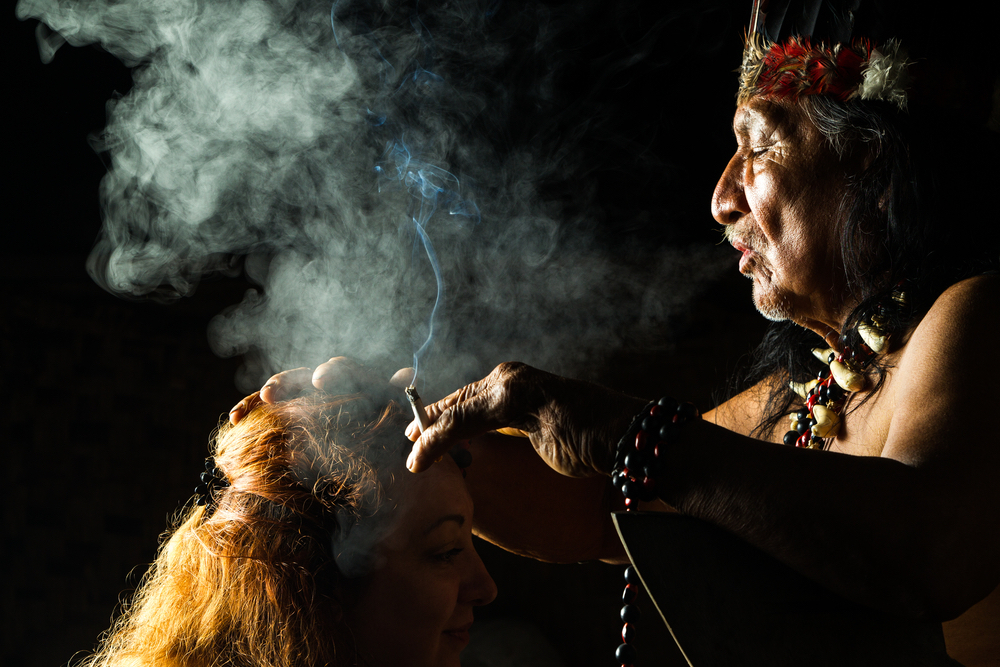
Image: Ammit Jack / Shutterstock
From the most remote regions of the Amazon rainforests, bringing with it remarkable health value as well as a dose of danger, comes the mysterious Ayahuasca ceremony. The Ayahuasca plant has been used traditionally by Amazonian shamans during rituals where it is consumed. The shamans are said to train for years before attempting to lead such ceremonies, learning to get to know the plant through a special diet of several months or longer, with the goal of understanding the language of the plant and its inherent spiritual applications. While current shamanistic adventures with the Ayahuasca ceremony tend to promote healing and positive transformation, past uses have embraced both good and bad intentions (such as manipulations in tricks of war, harming one’s enemies, attempting to gain power over others, etc.) and should be regarded as having such possibilities. Therefore, according to some sources, shamans should be viewed as humans with the potential for both good and bad intentions, not as saints or supernatural beings, in order to keep the proper perspective on the matter.
In some cases, those participating in the rituals will do so as part of a month-long (or longer) jungle “retreat”, said to be beneficial in separating the individual from harmful, negative social and emotional patterns present in their every day life. The retreats combine optimal nutritive changes to the nature-immersive rituals practiced, including the ayahuasca ceremony. The ayahuasca, once consumed, is said to promote a state of “conscious dreaming” which lasts up to two full days, during which participants may not speak or touch one another, so that unhealed emotion surfaces and can be reconciled. The benefits of these dream-like states can be compared to a transformative healing of the subconscious mind, which subsequently brings healing effects to the body, as the body is believed to manifest unconscious symptoms physically. Participants in such sacraments have reported miraculous and instantaneous healing of various illnesses. Others, although a rarity at this point, have had difficulties with ceremonies similar to the ayahuasca ceremony, during which one man reportedly killed another participant in Phoenix, Arizona during a frightful moment of his heightened ayahuasca-induced dream state. Such problems have not been prominent in retreats held in the indigenous regions, however. Ayahuasca has been made popular in the Amazon, while the San Pedro, a blend of rare, native cactus juices, has been derived from regions of the Andes and utilized with similar results. In order to become an ordained shaman, one must endure ayahuasca rituals at least twelve times. A full-length documentary showing the process of eight individuals who participated in the ancient Ayahuasca ceremonies from the day they left their homes for the Amazon and back is available here. These individuals, who suffered from a range of illnesses including Parkinson’s disease, prostate cancer, diabetes, IBS, Crohn’s disease, breast cancer, and more experienced varying results from the ceremonies.
Since the potency and success of the indigenous ceremonies have been shared widely throughout western culture, an assortment of similar experiences (such as the aforementioned event in Phoenix) have subsequently sprung up in varying geographies across the United States and the rest of the world. These new versions, however well-intentioned, must be examined carefully and responsibly before participation on any level. According to some sources, there are certain specific areas of consideration which must be addressed prior to joining in on such events. And although countless links to such ceremonies or similar events can be found in a simple internet search, it is advisable that one know the true reputation and capacities of staff present, as well as the environmental sustainability, respect for shamanic traditions, and other factors relevant to the issue. Being able to trust the people leading the ceremony is paramount and should never be taken lightly.
As we enter a new phase in nutritional health and well-being, there is no doubt a higher value being placed on our Earth’s rare and precious medicinal plants — such as the Ayahuasca. Since many of these natural phenomenons exist only in remote regions being destroyed for other resources at ever-increasing speeds, we must insist upon protective measures to guide our harvesting and potentially overwhelming presence in these fragile ecosystems. We must decrease deforestation and apply a greater emphasis on preservation in all such areas. As we embark on paths we’ve never before wandered, we must listen to the warnings of indigenous cultures along the way, and consult those who know these regions the best. In some cases it seems to be just as the shamans say, “the plants themselves will guide you.”
Have you participated in an ayahuasca ceremony? What was it like?
